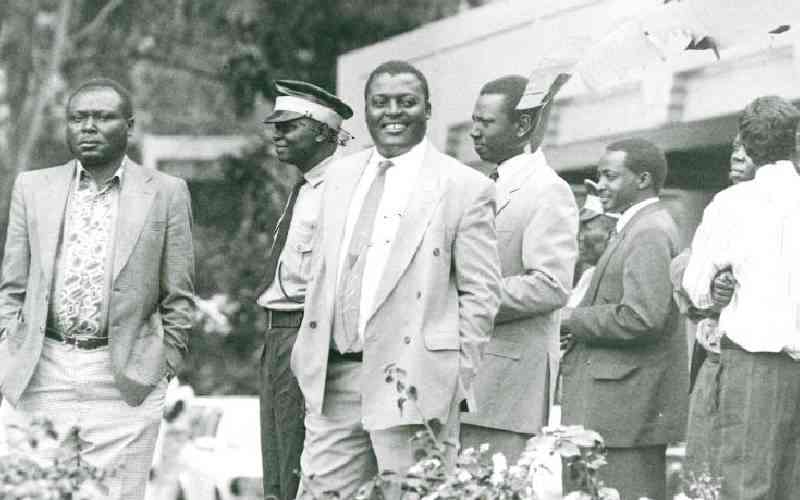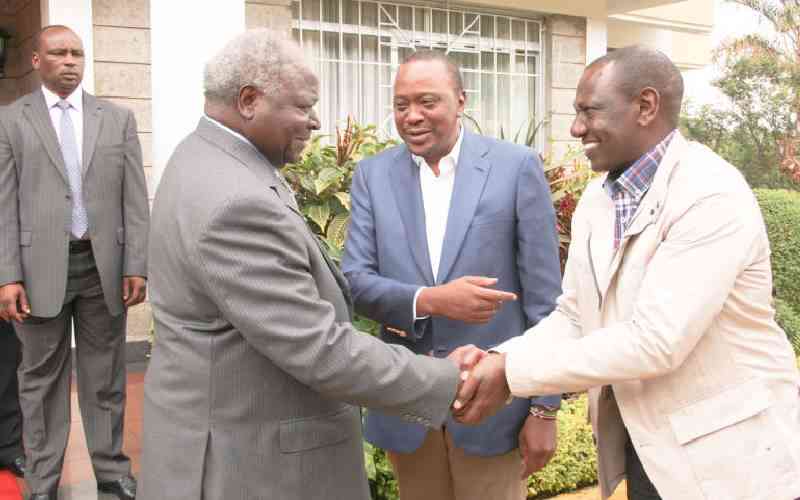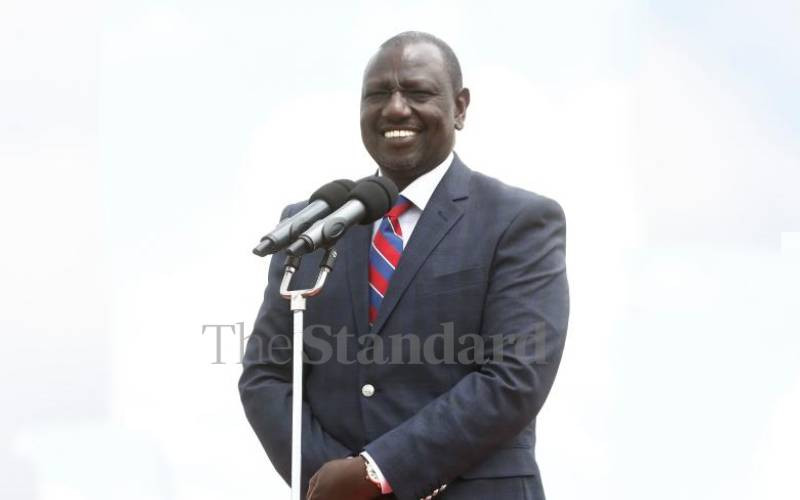For Ruto, the journey to the highest office in the country has been in the making for more than 20 years.
By being declared as the validly elected fifth president of Kenya, Ruto has scored a first by being the first candidate to run for the presidency and win at the first attempt since the reintroduction of multi-party democracy in Kenya in the early 1990s.
Pundits had seen Ruto’s attempt as suicidal considering that he was running against the wishes of his boss president Uhuru Kenyatta.
Common sentiment had it that with instruments of State at the president’s disposal, the president would ensure that Ruto would end up on the opposition side. It didn’t happen.
After being edged out of the Jubilee Party, which he built with the president, Ruto was compelled to have his political vehicle, the United Democratic Alliance, which later enlisted the support of smaller parties to form the Kenya Kwanza Alliance, which Kenya Alliance catapulted him to the presidency.
For the better part of his second term as the Deputy President, Ruto was practically out of the government courtesy of Executive Order Number one of 2019.
By Executive Order 1/2019, the President established a Cabinet committee on coordination and implementation chaired by the Cabinet Secretary Interior [Dr Fred Mataing’i], to coordinate the implementation of the Big Four agenda. This left the number two man virtually jobless. He would later disclose he was denied intelligence briefs and excluded from National Security Committee meetings.
The only time Ruto would be seen playing a role in affairs of the State was when he would welcome the President to address Kenyans during national days. Or when he chaired Intergovernmental Budget and Economic Council.
The president had earlier indicated his displeasure with his deputy whom he accused of loitering [kutanga tanga] by which he mean premature campaigns for the 2022 election.
Ruto would win the election by among other factors securing the support of the vote-rich Mt Kenya region and gaining inroads in Raila Odinga bastions such as the Ukamabani region where he 250, 000 votes.
Born on December 21 1966, in Kamagut village, 15kms from Eldoret, near the Webuye – Kitale junction, Ruto rose from humble beginnings.
He has often narrated the story of his time as a chicken seller while still a pupil at Kamagut, after moving from Kerotet Primary School.

He passed his exams and joined Wareng Boys High School in Eldoret municipality in 1981 and, thereafter, moved to Kapsabet Boys High School for his ‘A’ levels in 1985.
Ruto joined the University of Nairobi in 1986 to pursue a Bachelor of Science degree in Botany and Zoology, graduated in 1990 and returned to the same university years later to graduate with a Master of Science degree in 2011 and a Doctor of Philosophy (PhD) in Plant Ecology in 2018. After his first degree, Ruto tried his hand in business and together with friends, registered a trading company.
Two years ago he told a television station that seed money for his businesses came from the proceeds of a land sale.
He said, together with friends, they applied for the land and got it with the help of President Daniel arap Moi.
With the same money, he also bought his first car.
Return of multiparty
In 1990s, Kanu and President Daniel Moi faced stiff opposition from new parties like Jaramogi Oginga Odinga’s Ford Kenya, Kenneth Matiba’s Ford Asili and Mwai Kibaki’s DP after the reintroduction of multi-party politics.
A group of young Kenyans led by Cyrus Jirongo, who later became the MP for Lugari, Fred Amayo, Gerald Bommet and Sam Nyamweya then teamed to form the Youth for Kanu ‘92 (YK ‘92) pressure group to campaign for Moi’s re-election.
Sensing the opportunity, Ruto decided to work with the party but instead of teaming with the more flamboyant team who may be could not have accommodated him, the budding politician chose to operate from the party secretariat at KICC under Prof Julia Ojiambo.
He slowly built his profile as a hard-working party youth, who faithfully ran errands for top officials at the KICC offices as he also got the opportunity to interact with the YK officials.
It was during that period that Ruto slowly began featuring in Uasin Gishu Kanu politics and then joined a group that defeated then Eldoret North MP Reuben Chesire’s team in the district party elections.
The fast-rising politician would later briefly occupy the position of district Kanu branch chairman as he laid the ground for the 1997 elections when he vied and dislodged Chesire.

During that election, he teamed up with Jirongo. He then served from the opposition benches and together with Jirongo, Kipruto Kirwa and other youthful MPs became rebels within the party and briefly formed the United Democratic Movement (UDM) party before they quickly abandoned it and went back to Kanu.
Succession plan
Back in the fold, Ruto became increasingly involved in party matters with the likes of Julius Sunkuli, as President Moi began working on his succession plan that later backfired after he picked Uhuru Kenyatta as his preferred successor.
Moi had earlier at the tail end of his leadership appointed Ruto as an Assistant minister in the Office of the President from 1998 to 2002 and later elevated him to the full Cabinet portfolio as Minister for Home Affairs for three months, when Musalia Mudavadi was also promoted to be Vice President.
After Kanu lost, Ruto moved to the opposition benches and became increasingly vocal about the mistreatment of Moi by President Mwai Kibaki’s allies.
A group led by Raila Odinga and other disgruntled politicians allied to the Liberal Democratic Party wing of the National Rainbow Coalition, among them, Cabinet ministers Kalonzo Musyoka, Prof Anyang’ Nyong’o, Ochillo Ayacko, William ole Ntimama, Najib Balala and Linah Kilimo were sacked for opposing a draft constitution presented to a referendum in 2005.
They went on to form the Orange Democratic Movement (ODM), derived from the Orange symbol of the No’ side and were joined by Kanu leaders led by Uhuru and Ruto, who had ganged up with them to oppose the draft constitution, among others, retaining the presidential system and attempting to reintroduce regionalism.
Ruto used the opportunity to lead senior politicians in the Rift Valley like Henry Kosgey to defect to ODM. When ODM split, Kalonzo’s ally Dan Maanzo ran away with the ODM-Kenya registration certificate, denying Raila the vehicle he wanted to use for his 2007 presidential bid.
Ruto remained with him in ODM after securing the registration certificate from lawyer Mugambi Imanyara. Ruto stuck with him even as Uhuru moved to the Party of National Unity to back Kibaki’s re-election.
Agriculture minister
In the grand coalition government formed after the 2007/08 post-election government, Ruto served as Agriculture minister.
But a fallout would soon see Raila, in 2009, as Prime Minister, suspend Ruto from the government. President Mwai Kibaki, however, refused to enforce the move.
On April 21, 2010, Ruto was transferred to the Ministry of Higher Education swapping places with Raila ally, Dr Sally Kosgey.

In 2011, he was named among the six individuals accused of having planned and sponsored the 2007-08 post-election violence in which 1,200 people were killed and many others displaced following the disputed 2007 presidential election.
His case at The Hague-based ICC would later collapse in 2016.
Ahead of the 2013 elections, Ruto joined forces with Uhuru to form the Jubilee Alliance with Uhuru as the candidate and Ruto as running mate. They defeated the Coalition for Reforms and Democracy (Cord), which had fronted Raila and Kalonzo, to form the government.
Uhuru and Ruto were re-elected in 2017 in an election that would be annulled by the Supreme Court.
A repeat election was held but Raila and his allies in Nasa boycotted. Uhuru and Ruto soon fell out over what has been termed as his premature 2022 campaigns.
Prof Amukoa Anangwe, a lecturer of political science, was in Cabinet when Ruto was first appointed Assistant minister and describes him as a hands-on person.
“I think Ruto thrives when he is a victim of the situation. He knows how to manipulate the situation to win votes,” adds Anangwe.
Ruto has since 2018 complained about being sidelined by Uhuru and cited the removal of his allies from committees in Parliament among other issues.
How friends describe Ruto
Ruto cut his political teeth at the university, where he was a member of a district students’ association.
He saw the open opportunities that existed at the time to reach out to politicians through the association and thereafter hustled his way to the top.
Former Assistant Minister for Agriculture Joseph Misoi, who also served as the ODM Director of Elections says he has known Ruto since 1990s. Misoi was a former MP for Eldoret South since 1988 and then became Assistant minister for Agriculture in 1992.

“In 1997, he (Ruto) was a Kanu official in charge of distributing election materials and campaign funds because I used to visit his Jogoo House office for assistance towards my campaigns,” recalls Misoi.
In 2007, Misoi became the chief agent for the Raila campaign while Ruto was in the ODM pentagon as a chief campaigner. The former MP says Ruto was a team player with whom they worked closely and only differed during the 2010 referendum when he opposed the new constitution.
The DP’s schoolmates at Wareng High School in Eldoret and at Kapsabet High school in Nandi also regard him highly. They remember him as a focused, disciplined and active student who took his responsibilities and studies seriously.
“Ruto does not deviate from his goals and is always a go-getter and that is exactly how he was in school,” says Richard Tuimur, his schoolmate at Kapsabet Boys High School.
Timur is currently the principal of Kipsangui Boys High school in Merewet area of Soy constituency in Uasin Gishu. The DP, he says, was also very active in ball games, especially volleyball.
Classmates remember Ruto
Another former school mate Silas Simotwo, Ruto’s classmate in Form One at Wareng Secondary School in Uasin Gishu from 1981 remembers him as a strong leader of the Christian Union and dining hall prefect.
Those that schooled with him at Kamagut Primary School, say he was an above-average student. Samuel Kiplelei, who used to sell chicken at the Eldoret- Webuye-Kitale junction, also known as Maili Tisa, remembers seeing Ruto running around with chicken to sell to motorists.
“I remember seeing Ruto competing with others to sell chicken at this point during weekends, although I was younger than them,” says Kiplelei.
As a family man, the DP is close to his children and recently married off his daughter and also attended the Koito engagement ceremony of his son.




















Discussion about this post